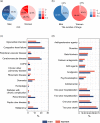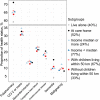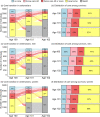Centenarians: who are they? A description of the total Swedish centenarian population in terms of living arrangements, health, and care utilization
- PMID: 37668844
- PMCID: PMC10628024
- DOI: 10.1007/s40520-023-02555-z
Centenarians: who are they? A description of the total Swedish centenarian population in terms of living arrangements, health, and care utilization
Abstract
Background: The global centenarian population has doubled each decade and is expected to continue growing. However, information regarding how they live, their health status, and care needs is limited.
Aims: This study aims to describe the total Swedish centenarian population in terms of health status, living arrangements, and socio-demographic characteristics.
Methods: This nationwide register-based study included all Swedish people reaching age 100 between 2013 and 2018. We analyzed their socio-demographic characteristics, living arrangements, number of prescribed drugs, and health status. Moreover, their care transitions from age 100 and two years forward were described.
Results: Of 5,882 centenarians (80.7% women), only 15.0% lived at home without formal care and 24.5% cohabited on their 100th birthday. Men (22.7%) were more likely than women (13.2%) to live at home without care. Approximately half of the centenarians lived in care homes, with fewer men (41.0%) than women (54.0%). Around 66.6% had a child living within the 50 km range. Most (76.5%) had an income below the median for Swedish older adults. Almost none were free from drugs, and polypharmacy was common (65.3%). Over half had at least one morbidity. Two years later, only 4.3% lived at home without care, and 63.9% died.
Conclusion: Sweden's centenarian population is highly dependent on home care and care homes. Among the ones still living at home, the vast majority live alone and have low incomes. Strategies to manage health and social care demands of this growing population group in the coming decade are important.
Keywords: Exceptional longevity; Home care services; Long-term care; Registries.
© 2023. The Author(s).
Conflict of interest statement
The authors have no conflicts of interest to disclose.
Figures



Similar articles
-
Centenarians' Marital History and Living Arrangements: Pathways to Extreme Longevity.J Gerontol B Psychol Sci Soc Sci. 2016 Jul;71(4):724-33. doi: 10.1093/geronb/gbv082. Epub 2015 Sep 23. J Gerontol B Psychol Sci Soc Sci. 2016. PMID: 26400840
-
Health Status, Living Arrangements, and Service Use at 100: Findings From the Oporto Centenarian Study.J Aging Soc Policy. 2016 Jul-Sep;28(3):148-64. doi: 10.1080/08959420.2016.1165582. J Aging Soc Policy. 2016. PMID: 27010687
-
Cohort profile: 'Centenari a Trieste' (CaT), a study of the health status of centenarians in a small defined area of Italy.BMJ Open. 2018 Feb 8;8(2):e019250. doi: 10.1136/bmjopen-2017-019250. BMJ Open. 2018. PMID: 29439076 Free PMC article.
-
Do men and women follow different trajectories to reach extreme longevity? Italian Multicenter Study on Centenarians (IMUSCE).Aging (Milano). 2000 Apr;12(2):77-84. doi: 10.1007/BF03339894. Aging (Milano). 2000. PMID: 10902049 Review.
-
Demographic, phenotypic, and genetic characteristics of centenarians in Okinawa and Japan: Part 1-centenarians in Okinawa.Mech Ageing Dev. 2017 Jul;165(Pt B):75-79. doi: 10.1016/j.mad.2016.11.001. Epub 2016 Nov 12. Mech Ageing Dev. 2017. PMID: 27845177 Review.
Cited by
-
Health Trajectories of Independent and Dependent Centenarians: A Swedish Nationwide Cohort Study.Innov Aging. 2025 Jun 23;9(6):igaf050. doi: 10.1093/geroni/igaf050. eCollection 2025. Innov Aging. 2025. PMID: 40718657 Free PMC article.
-
Do people reach 100 by surviving, delaying, or avoiding diseases? A life course comparison of centenarians and non-centenarians from the same birth cohorts.Geroscience. 2025 Jun;47(3):3539-3549. doi: 10.1007/s11357-024-01330-w. Epub 2024 Aug 30. Geroscience. 2025. PMID: 39212787 Free PMC article.
-
Gut microbiota in centenarians: A potential metabolic and aging regulator in the study of extreme longevity.Aging Med (Milton). 2024 Jun 14;7(3):406-413. doi: 10.1002/agm2.12336. eCollection 2024 Jun. Aging Med (Milton). 2024. PMID: 38975304 Free PMC article. Review.
-
Functional outcomes following injury in centenarians: a nationwide retrospective observational study.World J Emerg Surg. 2025 Apr 4;20(1):28. doi: 10.1186/s13017-025-00595-6. World J Emerg Surg. 2025. PMID: 40186255 Free PMC article.
References
-
- United Nations, Department of Economic and Social Affairs, Population Division (2022) World Population Prospects 2022, Online Edition.
MeSH terms
Grants and funding
LinkOut - more resources
Full Text Sources

